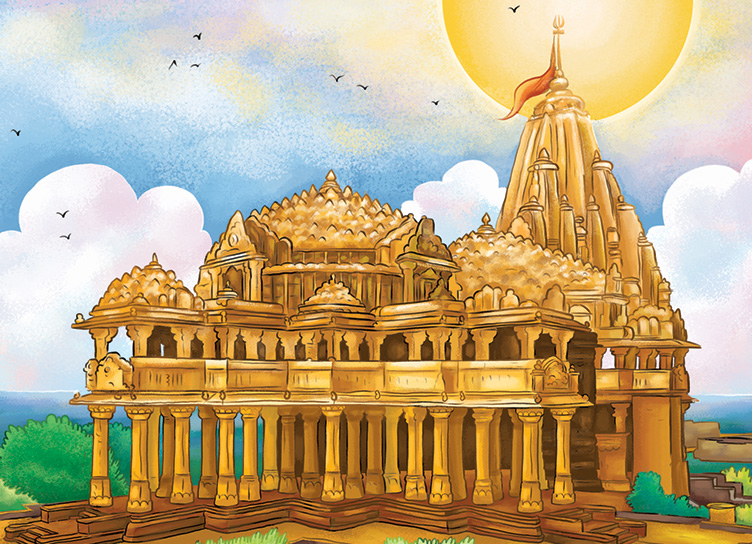Temples that Rose from the Ashes
- May 2, 2025


Temples that Rose from the Ashes
- May 2, 2025
by Shree Sauparnika V
Temples in India are not just structures of stone and mortar — they are living legacies. They carry echoes of chants, the rhythm of footsteps, and the weight of centuries. In their silence, they have witnessed celebration and sorrow, kings and commoners, seasons of abundance and times of destruction. Some still stand as they did long ago. Others have stumbled through time — shaken by nature, broken by war, forgotten by generations. And yet, many of these temples return to us — not just rebuilt, but reborn.
Temples have been vulnerable to the whims of nature. Earthquakes shattered sanctums, like those in Bhuj during the 2001 quake. Rivers shifted their course, swallowing temple towns whole. Entire settlements once flourishing along the Saraswati and Ghaggar-Hakra faded into dust. In 2013, when a massive flood swept across Uttarakhand, the ancient Shri Kedarnath Temple was caught in the path of destruction. Entire villages disappeared. But the temple stood — shielded by a massive boulder, which devotees believe was placed by divine grace. In the face of ruin, the stone walls of Kedarnath whisper a story of survival.
To receive more such stories in your Inbox & WhatsApp, Please share your Email and Mobile number.
But not all wounds come from the earth and sky. Through centuries, the Indian subcontinent has seen waves of invasions and power struggles. Temples, often rich in material and symbolic value, became targets. The Shri Somnath Jyotirlinga Temple in Gujarat faced repeated destruction — famously by Mahmud of Ghazni in the 11th century, and later during other periods of conflict. Yet, with every fall, the temple rose again. In 1951, it was rebuilt once more — this time as a national symbol of resilience, inaugurated by then President Rajendra Prasad. Today, it faces the Arabian Sea like a sentinel of memory, its past woven into its present.

Sometimes, the erasure of temples was not through war, but through policy and changing tides of belief. The magnificent Martand Surya Temple in Anantnag, Kashmir — built in the 8th century by King Lalitaditya Muktapida — was among the earliest and grandest temples dedicated to the sun. In the 15th century, it was ordered to be destroyed. What remains today is a hauntingly beautiful shell: a skeleton of pillars and sanctums open to the sky, still whispering tales of devotion, light, and loss.
There are other temples that vanished, not with a bang, but with silence. Some, like the Sri Airavatesvara Temple in Dharasuram, Tamil Nadu—a jewel of Chola architecture—simply fell out of sight. Overgrown, encroached upon, forgotten. But with patient effort by conservationists and renewed curiosity from visitors, the temple has once again become a place of admiration and awe. Its carved stone wheels, elegant horses, and musical steps remind us of an age where art, devotion, and architecture were one.

Even temples that never faced outright destruction have stories of disappearance. The Shri Padmanabhaswamy Temple in Thiruvananthapuram, Kerala, long revered but quiet in the public eye, startled the world in the 2010s when its ancient underground vaults were opened. Inside, lay treasures — gold, jewels, and sacred heirlooms preserved for centuries. But more than wealth, what the world discovered was the quiet continuity of faith. A temple that had held its silence had now become the centre of national wonder.

Temples rise again because someone remembers to light a lamp. Because someone sweeps the courtyard, or re-tells an old story, or dreams of what once was. Sometimes it is a community, sometimes a single devotee, sometimes a child asking a question. And in that act of remembering, history breathes again.
Destruction is easy. But to rebuild — to care, to restore, to pass the story on — that is the work of generations. And it is a work we continue to do, through every article, every comic, every story we tell. Because in remembering the temples that rose from the ashes, we also celebrate something deeply human: our capacity to hope, to heal, and to begin again.
Read more about the Ancient Temples of India at our ACK App.
To receive more such stories in your Inbox & WhatsApp, Please share your Email and Mobile number.

Comic of The Month
The Naval Journey of India Book I
This book is the first of a three-book series that takes a deep and detailed look at India's Naval History and a deep insight into the lives of our men and women in white. But any series on the Indian Navy has to start at the very beginning - exploring India's celebrated maritime history. Join our little hero, Bharat, and his grandfather, Commodore Sagar, as they sail into the deep blue waters of time. Book I of The Naval Journey of India takes a sweeping look at India's maritime endeavours, how the seas impacted us over millennia and how the oceans made us who we are.